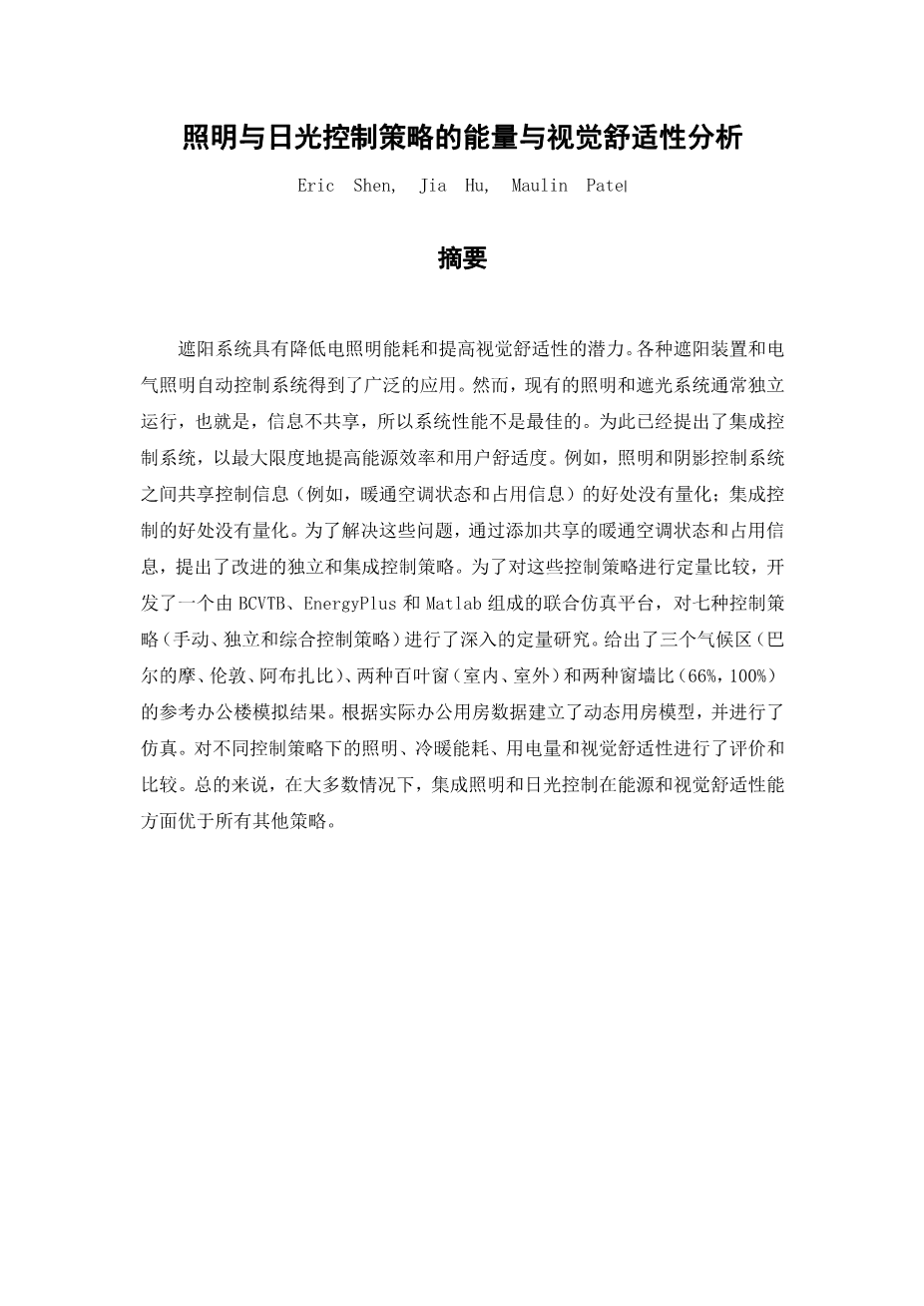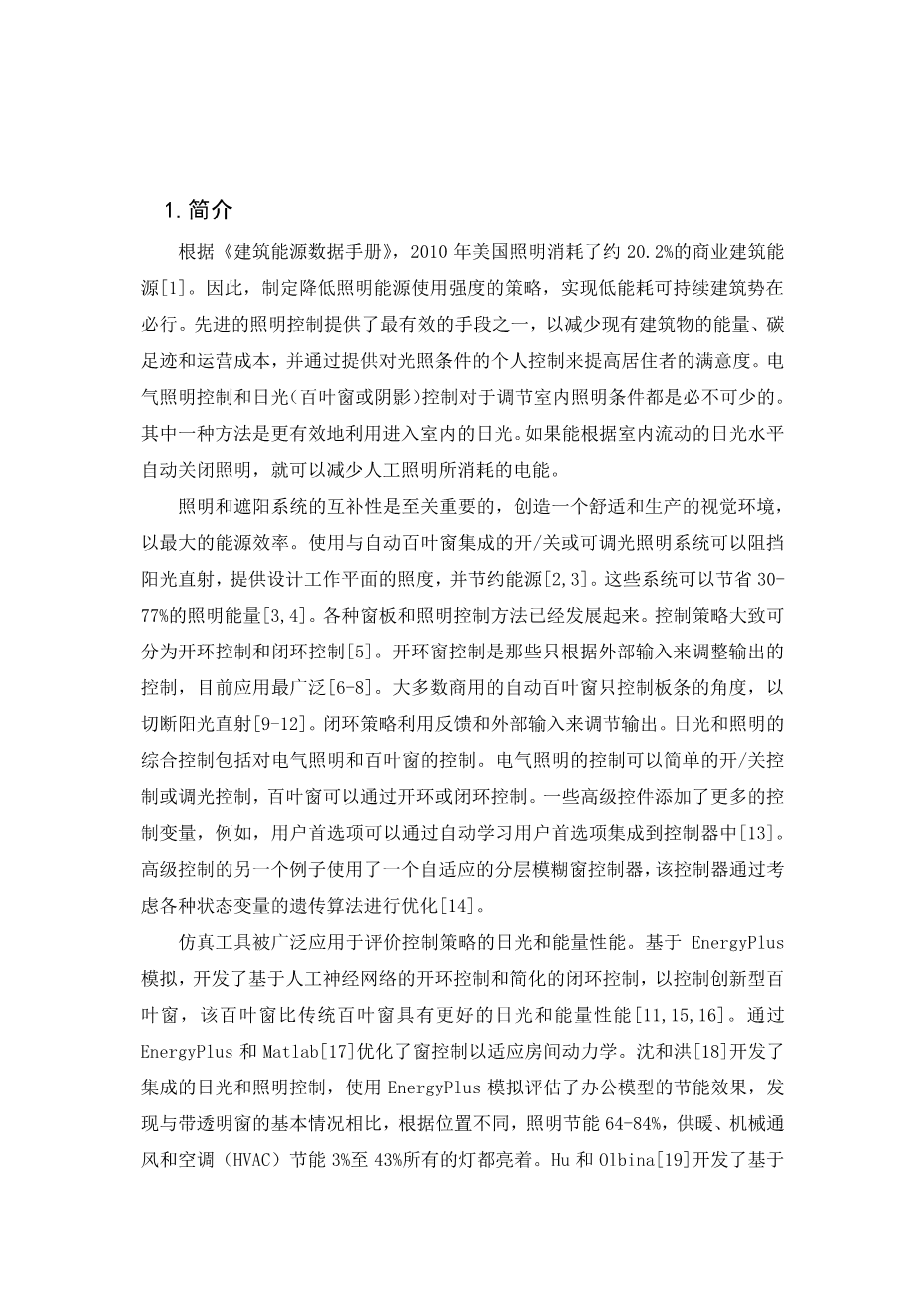Energy and visual comfort analysis of lighting and daylight control strategies
abstract
Shading systems have the potential to reduce energy consumption of electric lighting and improve visual comfort. Various automated control systems of shading device and electric lighting have been widely used. However, existing lighting and shading systems typically operate independently, i.e., information is not shared, and thus system performance is not optimal. Therefore, integrated control systems have been proposed to maximize energy efficiency and user comfort. Some problems are still unaddressed. For example, the benefits of sharing control information (e.g., HVAC state and occupancy information) between the lighting and shading control systems have not been quantified; the benefits of integrated controls have not been quantified. To address these issues, improved independent and integrated control strategies were proposed by adding shared HVAC state and occupancy information. To provide a quantitative comparison of these control strategies, a co-simulation platform consisting of BCVTB, EnergyPlus and Matlab was developed to perform an in-depth quantitative study of seven control strategies (manual, independent and integrated control strategies). Simulation results for a reference office building were presented for three climate zones (Baltimore, London, Abu-Dhabi), two types of blinds (interior, exterior) and two window-to-wall ratios (66%, 100%). A dynamic occupancy model was developed from actual office occupancy data and used in the simulations. The lighting, heating and cooling energy consumption, electric demand and visual comfort of different control strategies were evaluated and compared. Overall, in most cases, integrated lighting and daylight control outperforms all other strategies in energy and visual comfort performance.
窗体顶端
- Introduction
According to the Buildings Energy Data Book, lighting consumed about 20.2% of the commercial building energy in U.S. in 2010 [1]. It is therefore imperative to develop strategies that minimize the lighting energy usage intensity to realize low-energy sustainable buildings. Advanced lighting controls offer one of the most costeffective means to reduce the energy, carbon footprint, and operating costs of existing buildings, and to improve occupant satisfaction by providing personal control over light conditions. Electric lighting control and daylight (blinds or shades) control are both essential for regulating interior lighting conditions. One of the methods is to exploit the daylight coming into indoor areas more effectively. If the lighting can be automatically turned off according to the level of daylight flowing indoors, the amount of electrical energy consumed for artificial lighting can be thereby reduced.
It is critical for both lighting and shading systems to complement each other to create a comfortable and productive visual environment with maximum energy efficiency. The use of on/off or dimmable lighting systems integrated with automated blinds can block direct sunlight, provide the design workplane illuminance, and save energy [2,3]. These systems can result in lighting energy savings of 30e77% [3,4]. Various blind and lighting control methods have been developed. The control strategies can be broadly divided into open-loop and closed-loop controls [5]. Open-loop blind controls are those that adjust the output based on external input only and are deployed most widely today [6e8]. Most commercially available automated venetian blinds only control the slat angles to cutoff direct sunlight [9e12]. Closed-loop strategies employ feedback along with external input to regulate the output. Integrated control of daylight and lighting involves control of electric lighting and blinds. Control of electric lighting can be simply on/off control or dimming control, and blinds can be controlled by open-loop or closed-loop controls. Some advanced controls add more control variables, for example, user preferences may be integrated into the controller by automatically learning user preferences [13]. Another example of advanced control uses an adaptable hierarchical fuzzy blind controller optimized by genetic algorithms that consider various state variables [14].
Simulation tools have been widely used to evaluate the daylight and energy performance of control strategies. Based on EnergyPlus simulations, an artificial neural network based open-loop control and a simplified closed-loop control were developed to control innovative blinds that can provide better daylight and energy performance than conventional blinds [11,15,16]. A blind control was optimized to adapt to room dynamics through EnergyPlus and Matlab [17]. Shen and Hong [18] developed an integrated daylight and lighting control, evaluated the energy savings in an office model using EnergyPlus simulations, and found lighting energy savings of 64e84%, and heating, mechanical ventilation and airconditioning (HVAC) savings from 3% to 43% depending on location, compared to a base case with clear windows and all lighting fully on. Hu and Olbina [19] developed daylight and energy prediction methods based on EnergyPlus and Radiance simulations, and found that the method can provide a fast evaluation of blind and lighting control strategies for space with combinations of different blind reflectance and glazing transmittance. Tzempelikos and Shen [20] compared four different dynamic roller shading control strategies with constant and variable set points by using a finite difference thermal network approach and a radiosity-based method [21], and found that different control strategies should be used in different orientations. Using hybrid ray-tracing and radiosity methods for calculating radiation transport and illuminance distribution [22], Chan and Tzempelikos [23] evaluated four control strategies:
剩余内容已隐藏,支付完成后下载完整资料


英语译文共 30 页,剩余内容已隐藏,支付完成后下载完整资料
资料编号:[419088],资料为PDF文档或Word文档,PDF文档可免费转换为Word
以上是毕业论文外文翻译,课题毕业论文、任务书、文献综述、开题报告、程序设计、图纸设计等资料可联系客服协助查找。


